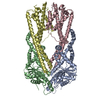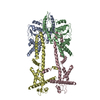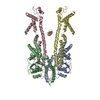[English] 日本語
 Yorodumi
Yorodumi- PDB-8cr2: Homo sapiens Get1/Get2 heterotetramer (a3' deletion variant) in c... -
+ Open data
Open data
- Basic information
Basic information
| Entry | Database: PDB / ID: 8cr2 | |||||||||
|---|---|---|---|---|---|---|---|---|---|---|
| Title | Homo sapiens Get1/Get2 heterotetramer (a3' deletion variant) in complex with a Get3 dimer | |||||||||
 Components Components |
| |||||||||
 Keywords Keywords |  MEMBRANE PROTEIN / MEMBRANE PROTEIN /  membrane protein insertion / GET pathway / tail anchored membrane protein membrane protein insertion / GET pathway / tail anchored membrane protein | |||||||||
| Function / homology |  Function and homology information Function and homology informationarsenite transmembrane transporter activity / receptor recycling / membrane insertase activity / GET complex / tail-anchored membrane protein insertion into ER membrane /  Hydrolases; Acting on acid anhydrides / protein insertion into ER membrane / Hydrolases; Acting on acid anhydrides / protein insertion into ER membrane /  post-translational protein targeting to endoplasmic reticulum membrane / Insertion of tail-anchored proteins into the endoplasmic reticulum membrane / B cell homeostasis ...arsenite transmembrane transporter activity / receptor recycling / membrane insertase activity / GET complex / tail-anchored membrane protein insertion into ER membrane / post-translational protein targeting to endoplasmic reticulum membrane / Insertion of tail-anchored proteins into the endoplasmic reticulum membrane / B cell homeostasis ...arsenite transmembrane transporter activity / receptor recycling / membrane insertase activity / GET complex / tail-anchored membrane protein insertion into ER membrane /  Hydrolases; Acting on acid anhydrides / protein insertion into ER membrane / Hydrolases; Acting on acid anhydrides / protein insertion into ER membrane /  post-translational protein targeting to endoplasmic reticulum membrane / Insertion of tail-anchored proteins into the endoplasmic reticulum membrane / B cell homeostasis / negative regulation of proteasomal ubiquitin-dependent protein catabolic process / protein-membrane adaptor activity / negative regulation of protein ubiquitination / vesicle-mediated transport / defense response / epidermal growth factor receptor signaling pathway / protein stabilization / post-translational protein targeting to endoplasmic reticulum membrane / Insertion of tail-anchored proteins into the endoplasmic reticulum membrane / B cell homeostasis / negative regulation of proteasomal ubiquitin-dependent protein catabolic process / protein-membrane adaptor activity / negative regulation of protein ubiquitination / vesicle-mediated transport / defense response / epidermal growth factor receptor signaling pathway / protein stabilization /  ubiquitin protein ligase binding / endoplasmic reticulum membrane / ubiquitin protein ligase binding / endoplasmic reticulum membrane /  nucleolus / nucleolus /  endoplasmic reticulum / endoplasmic reticulum /  signal transduction / signal transduction /  ATP hydrolysis activity / extracellular exosome / ATP hydrolysis activity / extracellular exosome /  nucleoplasm / nucleoplasm /  ATP binding / ATP binding /  membrane / membrane /  metal ion binding / metal ion binding /  nucleus / nucleus /  cytoplasm cytoplasmSimilarity search - Function | |||||||||
| Biological species |   Homo sapiens (human) Homo sapiens (human) | |||||||||
| Method |  ELECTRON MICROSCOPY / ELECTRON MICROSCOPY /  single particle reconstruction / single particle reconstruction /  cryo EM / Resolution: 4.2 Å cryo EM / Resolution: 4.2 Å | |||||||||
 Authors Authors | McDowell, M.A. / Heimes, M. / Wild, K. / Sinning, I. | |||||||||
| Funding support |  Germany, 2items Germany, 2items
| |||||||||
 Citation Citation |  Journal: Nat Commun / Year: 2023 Journal: Nat Commun / Year: 2023Title: The GET insertase exhibits conformational plasticity and induces membrane thinning. Authors: Melanie A McDowell / Michael Heimes / Giray Enkavi / Ákos Farkas / Daniel Saar / Klemens Wild / Blanche Schwappach / Ilpo Vattulainen / Irmgard Sinning /   Abstract: The eukaryotic guided entry of tail-anchored proteins (GET) pathway mediates the biogenesis of tail-anchored (TA) membrane proteins at the endoplasmic reticulum. In the cytosol, the Get3 chaperone ...The eukaryotic guided entry of tail-anchored proteins (GET) pathway mediates the biogenesis of tail-anchored (TA) membrane proteins at the endoplasmic reticulum. In the cytosol, the Get3 chaperone captures the TA protein substrate and delivers it to the Get1/Get2 membrane protein complex (GET insertase), which then inserts the substrate via a membrane-embedded hydrophilic groove. Here, we present structures, atomistic simulations and functional data of human and Chaetomium thermophilum Get1/Get2/Get3. The core fold of the GET insertase is conserved throughout eukaryotes, whilst thinning of the lipid bilayer occurs in the vicinity of the hydrophilic groove to presumably lower the energetic barrier of membrane insertion. We show that the gating interaction between Get2 helix α3' and Get3 drives conformational changes in both Get3 and the Get1/Get2 membrane heterotetramer. Thus, we provide a framework to understand the conformational plasticity of the GET insertase and how it remodels its membrane environment to promote substrate insertion. | |||||||||
| History |
|
- Structure visualization
Structure visualization
| Structure viewer | Molecule:  Molmil Molmil Jmol/JSmol Jmol/JSmol |
|---|
- Downloads & links
Downloads & links
- Download
Download
| PDBx/mmCIF format |  8cr2.cif.gz 8cr2.cif.gz | 173.3 KB | Display |  PDBx/mmCIF format PDBx/mmCIF format |
|---|---|---|---|---|
| PDB format |  pdb8cr2.ent.gz pdb8cr2.ent.gz | 130.8 KB | Display |  PDB format PDB format |
| PDBx/mmJSON format |  8cr2.json.gz 8cr2.json.gz | Tree view |  PDBx/mmJSON format PDBx/mmJSON format | |
| Others |  Other downloads Other downloads |
-Validation report
| Arichive directory |  https://data.pdbj.org/pub/pdb/validation_reports/cr/8cr2 https://data.pdbj.org/pub/pdb/validation_reports/cr/8cr2 ftp://data.pdbj.org/pub/pdb/validation_reports/cr/8cr2 ftp://data.pdbj.org/pub/pdb/validation_reports/cr/8cr2 | HTTPS FTP |
|---|
-Related structure data
| Related structure data |  16802MC  8cqzC  8cr1C  8oduC  8odvC M: map data used to model this data C: citing same article ( |
|---|---|
| Similar structure data | Similarity search - Function & homology  F&H Search F&H Search |
- Links
Links
- Assembly
Assembly
| Deposited unit | 
|
|---|---|
| 1 |
|
- Components
Components
| #1: Protein | Mass: 40146.070 Da / Num. of mol.: 2 Source method: isolated from a genetically manipulated source Details: Get3 was expressed in E. coli / Source: (gene. exp.)   Homo sapiens (human) / Gene: ASNA1, ARSA, TRC40 / Production host: Homo sapiens (human) / Gene: ASNA1, ARSA, TRC40 / Production host:   Escherichia coli (E. coli) Escherichia coli (E. coli)References: UniProt: O43681,  Hydrolases; Acting on acid anhydrides Hydrolases; Acting on acid anhydrides#2: Protein | Mass: 34429.418 Da / Num. of mol.: 2 Mutation: Truncation of 185 N-terminal residues. Residues 242-250 replaced with a GGGG linker Source method: isolated from a genetically manipulated source Details: Get2-Get1 was expressed as a fusion protein in S. frugiperda Source: (gene. exp.)   Homo sapiens (human) / Gene: CAMLG, CAML, GET2, GET1, CHD5, WRB / Production host: Homo sapiens (human) / Gene: CAMLG, CAML, GET2, GET1, CHD5, WRB / Production host:   Spodoptera frugiperda (fall armyworm) / References: UniProt: P49069, UniProt: O00258 Spodoptera frugiperda (fall armyworm) / References: UniProt: P49069, UniProt: O00258#3: Chemical | ChemComp-ZN / | Has ligand of interest | N | |
|---|
-Experimental details
-Experiment
| Experiment | Method:  ELECTRON MICROSCOPY ELECTRON MICROSCOPY |
|---|---|
| EM experiment | Aggregation state: PARTICLE / 3D reconstruction method:  single particle reconstruction single particle reconstruction |
- Sample preparation
Sample preparation
| Component |
| ||||||||||||||||||||||||||||
|---|---|---|---|---|---|---|---|---|---|---|---|---|---|---|---|---|---|---|---|---|---|---|---|---|---|---|---|---|---|
| Molecular weight |
| ||||||||||||||||||||||||||||
| Source (natural) |
| ||||||||||||||||||||||||||||
| Source (recombinant) |
| ||||||||||||||||||||||||||||
| Buffer solution | pH: 7.5 | ||||||||||||||||||||||||||||
| Buffer component |
| ||||||||||||||||||||||||||||
| Specimen | Conc.: 1.2 mg/ml / Embedding applied: NO / Shadowing applied: NO / Staining applied : NO / Vitrification applied : NO / Vitrification applied : YES / Details: Complex stabilised in PMAL-C8 amphipol : YES / Details: Complex stabilised in PMAL-C8 amphipol | ||||||||||||||||||||||||||||
| Specimen support | Grid material: COPPER / Grid mesh size: 300 divisions/in. / Grid type: Quantifoil R2/1 | ||||||||||||||||||||||||||||
Vitrification | Instrument: FEI VITROBOT MARK IV / Cryogen name: ETHANE / Humidity: 95 % / Chamber temperature: 279 K |
- Electron microscopy imaging
Electron microscopy imaging
| Experimental equipment |  Model: Titan Krios / Image courtesy: FEI Company |
|---|---|
| Microscopy | Model: FEI TITAN KRIOS |
| Electron gun | Electron source : :  FIELD EMISSION GUN / Accelerating voltage: 300 kV / Illumination mode: FLOOD BEAM FIELD EMISSION GUN / Accelerating voltage: 300 kV / Illumination mode: FLOOD BEAM |
| Electron lens | Mode: BRIGHT FIELD Bright-field microscopy / Nominal defocus max: 2400 nm / Nominal defocus min: 1200 nm / Cs Bright-field microscopy / Nominal defocus max: 2400 nm / Nominal defocus min: 1200 nm / Cs : 2.7 mm : 2.7 mm |
| Specimen holder | Cryogen: NITROGEN |
| Image recording | Average exposure time: 2.58 sec. / Electron dose: 53.2 e/Å2 / Detector mode: COUNTING / Film or detector model: GATAN K3 (6k x 4k) / Num. of grids imaged: 1 / Num. of real images: 12311 |
- Processing
Processing
| Software | Name: PHENIX / Version: 1.19_4092: / Classification: refinement | ||||||||||||||||||||||||||||||||||||
|---|---|---|---|---|---|---|---|---|---|---|---|---|---|---|---|---|---|---|---|---|---|---|---|---|---|---|---|---|---|---|---|---|---|---|---|---|---|
| EM software |
| ||||||||||||||||||||||||||||||||||||
CTF correction | Type: PHASE FLIPPING AND AMPLITUDE CORRECTION | ||||||||||||||||||||||||||||||||||||
| Particle selection | Num. of particles selected: 2044854 | ||||||||||||||||||||||||||||||||||||
| Symmetry | Point symmetry : C1 (asymmetric) : C1 (asymmetric) | ||||||||||||||||||||||||||||||||||||
3D reconstruction | Resolution: 4.2 Å / Resolution method: FSC 0.143 CUT-OFF / Num. of particles: 224354 / Symmetry type: POINT | ||||||||||||||||||||||||||||||||||||
| Atomic model building | Protocol: RIGID BODY FIT / Space: REAL | ||||||||||||||||||||||||||||||||||||
| Atomic model building | PDB-ID: 6SO5 Accession code: 6SO5 / Source name: PDB / Type: experimental model | ||||||||||||||||||||||||||||||||||||
| Refine LS restraints |
|
 Movie
Movie Controller
Controller





 PDBj
PDBj





